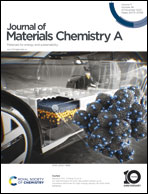ZnO quantum dots@covalent organic frameworks for high-performance alkaline zinc-based batteries†
Abstract
Alkaline zinc-based batteries have attracted tremendous attention because of their advantages of high energy density, high safety, and low cost. However, problems such as dendrites, hydrogen evolution, and anode passivation have seriously hindered their practical application. Herein, we combined covalent organic frameworks (COFs) with ZnO quantum dots (QDs) by covalent linkage as alkaline zinc-based anode materials. The smaller size of ZnO QDs has a larger specific surface area for full contact with the electrolyte. Additionally, the TpPa-1 COF provides an effective and direct channel for ion transport, and the TpPa-1 COF regulates the concentration gradient of Zn(OH)42−, which slows down the deformation and dendrite growth. An alkaline Zn–Ni battery is assembled with Ni(OH)2 as the cathode and maintains a discharge capacity of 540 mA h g−1 at 5C. It maintains a steady cycle at 12C, with capacity retention remaining at 90% after 2000 cycles and 87% after 4000 cycles. This strategy effectively solves the problems associated with alkaline zinc-based battery anodes, and therefore it is an important step toward the development of high-performance batteries.



 Please wait while we load your content...
Please wait while we load your content...